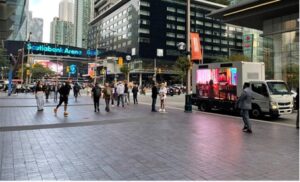Mobile Billboards in the Age of AI: The Future of Dynamic, Real-Time Advertising

Advertising is changing as a result of artificial intelligence (AI), which is making ads more data-driven, dynamic, and tailored than ever. Although AI-powered personalization has long been advantageous for digital marketing, mobile billboards are increasingly using AI to improve real-time ad relevance, optimize ad placement, and develop more intelligent Out-of-Home (OOH) campaigns.
Brands can make sure their mobile billboards convey the appropriate message to the appropriate people at the ideal moment by using AI-driven insights. However, as AI continues to influence OOH, how can marketers strike a balance between authenticity and hyper-targeted ads? How can AI-powered billboards avoid coming out as unduly robotic or obtrusive while still being interesting and natural?

Source: Movia Media
AI-Powered Real-Time Data: Personalizing OOH Like Never Before
Location-based tactics have always been a part of traditional billboard advertising, but AI elevates this strategy to a whole new level. Real-time data allows mobile billboards to dynamically modify their messaging according to audience demographics, traffic patterns, time of day, and location.
For instance, a coffee brand’s AI-powered mobile billboard can show different advertisements depending on the time of day, promoting chilled coffee in the midday heat and hot lattes during the morning rush hour. AI makes sure that advertisements are always relevant by evaluating real-time data, which boosts engagement and motivates customer action.
In addition to time-based customisation, AI can analyze outside data sources, such as regional events, meteorological conditions, and patterns in consumer behavior, to create well-informed ad modifications. For example, a mobile billboard that advertises running shoes might alter its message to promote outdoor exercise on a sunny day and switch to marketing waterproof gear when rain is predicted. This degree of flexibility guarantees that mobile billboards continue to react to their surroundings, producing advertising that seems relevant and natural.
This AI-driven strategy has been adopted by Movia, a pioneer in mobile billboard advertising, through the integration of Mobilytics, a sophisticated audience measurement platform that continuously monitors impressions, interaction, and campaign performance. By analyzing audience density and mobility patterns using passive Wi-Fi and Bluetooth monitoring, Mobilytics gives advertisers a comprehensive understanding of how and where their mobile billboards are having the greatest impact. Brands can use this data to refine messaging, modify routes, and make sure their campaigns are seen by the appropriate people at the right time.

Source: Movia Media
Optimizing Ad Placement: AI Knows Where & When to Deliver Your Message
OOH advertising has traditionally relied heavily on location, but AI makes this process more precise based on data. AI-powered mobile billboards may dynamically change their movements in real time, eliminating the need for static routes and optimizing ad delivery for optimum exposure and audience relevance.
Traffic Analysis: AI is able to recognize times of high traffic and reroute mobile billboards to areas with a high population density, guaranteeing that advertisements are seen by as many people as possible.
Demographic Targeting: AI systems use information on age, gender, and hobbies to place billboards where local customers are most likely to find them appealing.
Event-Based Advertising: By integrating with event calendars, AI automatically targets target audiences with mobile billboards at events like concerts, sporting events, or festivals.
By monitoring real-time audience interaction using Mobilytics, businesses can further optimize their campaigns and make mid-campaign tweaks that increase effectiveness and optimize return on investment. By increasing campaign efficacy and decreasing wasted impressions, this degree of real-time performance tracking guarantees that companies get the most out of their out-of-home advertising budget.

Source: Movia Media
Balancing Automation with Human-Centered Storytelling
Maintaining the authenticity and interest of advertisements is a challenge with AI-driven customisation. Advertising runs the risk of coming out as impersonal or unduly predictive when it gets too focused, which some customers find “creepy.”
Brands must strike a balance between human-centered storytelling and AI automation to counter this. Even if AI can decide when and where to display advertisements, the content should still be relatable, emotive, and consistent with the brand.
An AI-powered mobile billboard used by a fashion company, for instance, shouldn’t only show basic product advertisements according to the weather. A commercial that presents a relevant tale, like a busy professional discovering the ideal clothing for an evening out, may be displayed after using AI to detect peak purchasing hours. With this kind of narrative, the AI-powered campaign feels more like a real, brand-driven experience that engages customers rather than an algorithmic choice.
Furthermore, incorporating interactive elements like augmented reality (AR) or QR codes can aid in bridging the gap between human interaction and AI-driven automation. A two-way connection that feels intelligent and natural is produced when a mobile billboard can encourage audience participation, such as scanning a code for a customized offer or witnessing a digital experience.
The Future of AI in Mobile Billboard Advertising
Although AI is still in its infancy in the OOH sector, there is no denying that technology has the potential to completely transform mobile billboards. In the future, we can anticipate:
- Enhanced automation powered by AI, which enables businesses to program dynamic, self-optimizing billboard routes without the need for human interaction.
- Hyper-local personalization is the process by which mobile billboards adapt to certain streets, companies, or even a city or neighborhood.
- Deeper consumer device integration, where AI-powered OOH advertisements link to wearable technology, smartphones, and smart city infrastructure to provide more engaging experiences.
- Developments in speech and facial recognition that allow billboards to respond in real time to the emotions and expressions of their audience and modify their advertising content accordingly.
- Brands that use data-driven, responsive, and human-centered mobile billboard advertising will set the standard for OOH marketing as AI technology advances.

Source: Movia Media
Conclusion
Mobile billboards are being transformed by AI, becoming more intelligent, dynamic, and pertinent than ever. Mobile billboards can now respond to audience actions and environmental factors in ways that static ads could never before thanks to real-time data, AI-powered optimization, and hyper-personalized targeting.
But striking a balance between creativity and automation is crucial for success. Even though AI makes sure that mobile billboards appear at the appropriate moment, marketers still need to focus on telling compelling, emotionally charged stories to establish lasting and genuine connections.
Movia is leading this AI-driven revolution by providing marketers with real-time analytics through solutions like Mobilytics, guaranteeing that their mobile billboard campaigns are not just data-driven but also have a genuine impact.
Businesses who strategically adopt AI will stand out as it continues to shape OOH advertising, producing campaigns that are not simply seen but actually experienced.

Author
Casey Binkley,
Founder & CEO, Movia Media
